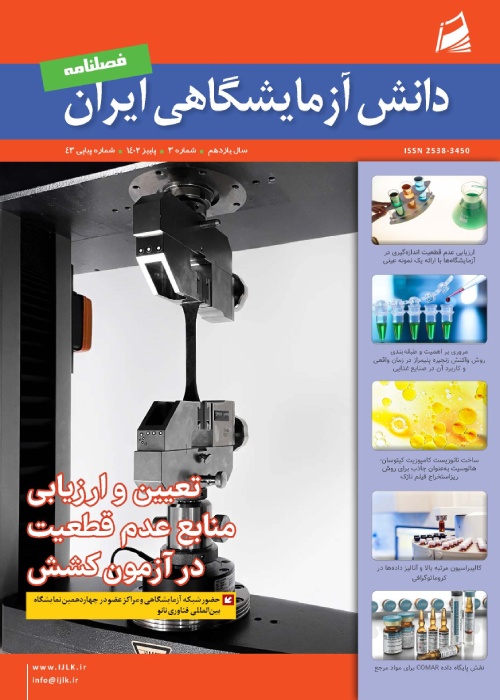فهرست مطالب

مجله دانش آزمایشگاهی ایران
پیاپی 43 (پاییز 1402)
- تاریخ انتشار: 1402/09/20
- تعداد عناوین: 8
-
صفحات 2-5
- استاندرد
- مقالات
-
صفحات 38-41
-
صفحات 42-46
-
Pages 7-12
In order to evaluate the measurement uncertainty, laboratories should identify the uncertainty contribution of various influencing factors on the measurand uncertainty and regularly review the measured uncertainty. In this research, the results of calculating the uncertainty of measuring the mass of a ball sample are presented using the QMSys GUM enterprise software. In order to validate the obtained results from the software, the uncertainty calculation was also done manually and compared with the results of the software. The results show that the obtained uncertainty by the manual method and the software are the same. Also, the results indicate that the contribution of the uncertainty of repeatability on the uncertainty of the measurand is greater than the other factors; therefore, the optimization of the obtained uncertainty is possible by increasing the number of repetitions of the test or training the examiner to provide more accurate results.
Keywords: Uncertainty, Influencing factors, Measurand, GUM method, Mass -
Pages 13-21
The progress in the field of molecular technology and biology (caused to accelerate the correct identification of closely related species in a raw material and product) led to the frequency of molecular tests for wide applications such as genetic fingerprinting for identification, diagnosis of infectious diseases, food sensitivities and fraud detection in in the food industry it seems necessary. Certainly, using traditional methods (based on culture) to detect diseases, antibiotics, and harmful microorganisms in the food industry will be costly and take a lot of time. That's why modern molecular methods like RT-PCR were brought in. They can quickly and accurately determine the specific species that cause infections and assess the food's safety and quality. In this new method, fluorescent molecules are used to detect the gene amplification process. This allows for accurate measurement of gene expression levels with minimal risk of contamination. This technique is highly sensitive and specific, providing reliable data. So, it can be used instead of regular PCR. This article talks about the different methods of RT-PCR, why it's important, and how it can be used to detect allergens in food, like gluten. It also mentions how it can help uncover cases of food fraud.
Keywords: RT-PCR technique, Technique classification, Detection of pathogenic bacteria, Detection of foodallergens, Food fraud -
Pages 22-31
This work introduced an environmentally friendly sorbent based on halloysite-chitosan nano-biocomposite for thin film microextraction (TFME). Chitosan as a biodegradable and biocompatible polymer was used to prepare thin film sorbent. To improve the mechanical and chemical resistance of the film and increasing the adsorption efficiency, halloysite nanotubes were combined with the chitosan to prepare the thin film sorbent. The film was used for TFME of 17α-ethynylestradiol followed by high-performance liquid chromatograph y-fluorescence detection. Effective parameters such as the amount of chitosan and halloysite, ionic strength of sample solution, type and volume of desorption solvent, desorption and extraction times were optimized. The linear dynamic range of the method was in the range of 1.0–50.0 μg L−1. The detection limit and relative standard deviation of the method were 0.4 μg L−1 and 9%, respectively. The method was validated for the TFME of 17α-ethynylestradiol in river water, wastewater, and tap water samples, and recoveries were found to be in the range 67–106%.
Keywords: Chitosan, Halloysite, Thin film microextraction, 17α-Ethynylestradiol, Water samples -
Pages 32-37
Multiway data analysis and tensorial calibration are gaining widespread acceptance with the rapid development of multichannel chromatographic instruments. By combining chromatographic techniques with chemometrics based on high-order calibration methods, some traditional problems in analysis, such as complicated pretreatment steps, long elution times, or even worse analysis results, can be avoided/improved. This chapter presents an overview from second-order to third-order data that cover theories and applications together with corresponding data processing in chromatography.
Keywords: chemometrics, second-order advantages, trilinear model, high-performance liquid chromatography-diode arraydetection, liquid chromatography-mass spectrometry -
Pages 38-41
The COMAR database is a comprehensive database for reference materials that plays an essential role in ensuring quality and creating reliability for reference materials used in laboratories. This article overviews the COMAR database, its importance, capabilities, and benefits for laboratories and related institutions.
Keywords: COMAR database, laboratory, reference material -
Pages 42-46
The measurement of a quantity has errors and uncertainties in the final size report, especially if this measurement is done with laboratory equipment. As a result, to obtain a more accurate value, attention is paid to the investigation and evaluation of the factors that create uncertainty in the final value. Therefore, in this research article, the factors and parameters that cause uncertainty in the final value of the tensile test, which is a widely used test for examining the mechanical properties of various materials such as steel in the construction of steel pipes for use in water, gas and oil transmission, are investigated. The device's uncertainty and the uncertainty resulting from the repeatability have been investigated and calculated. Finally, the ultimate stress of the tensile device in the laboratory of Qaem Pipe Rolling Company was investigated. The value of 72.62 kPa was calculated with an expanded uncertainty of 0.63 with a confidence factor of 95%. Also, according to the obtained information, the share of uncertainty of repeatability is more than other factors of uncertainty.
Keywords: Uncertainty, Tensile device, Repeatability, Type A-B uncertainty


